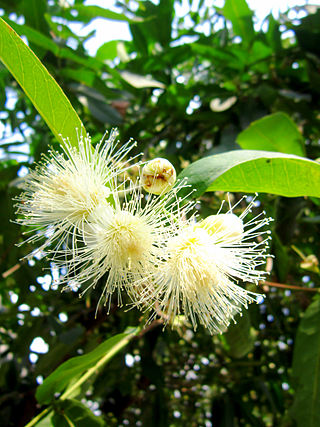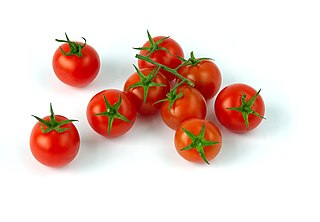
A berry is a small, pulpy, and often edible fruit. Typically, berries are juicy, rounded, brightly colored, sweet, sour or tart, and do not have a stone or pit, although many pips or seeds may be present. Common examples of berries in the culinary sense are strawberries, raspberries, blueberries, blackberries, white currants, blackcurrants, and redcurrants. In Britain, soft fruit is a horticultural term for such fruits.

Morus, a genus of flowering plants in the family Moraceae, consists of diverse species of deciduous trees commonly known as mulberries, growing wild and under cultivation in many temperate world regions. Generally, the genus has 64 subordinate taxa, three of which are well-known and are ostensibly named for the fruit color of the best-known cultivar: white, red, and black mulberry, with numerous cultivars and some taxa currently unchecked and awaiting taxonomic scrutiny. M. alba is native to South Asia, but is widely distributed across Europe, Southern Africa, South America, and North America. M. alba is also the species most preferred by the silkworm, and is regarded as an invasive species in Brazil and the United States.

Sambucus is a genus of flowering plants in the family Adoxaceae. The various species are commonly referred to as elder, elderflower or elderberry.

Malus is a genus of about 32–57 species of small deciduous trees or shrubs in the family Rosaceae, including the domesticated orchard apple, crab apples and wild apples.

Syzygium samarangense is a species of flowering plant in the family Myrtaceae, native to an area that includes the Greater Sunda Islands, Malay Peninsula, and the Andaman and Nicobar Islands, but introduced in prehistoric times to a wider area and now widely cultivated in the tropics. Common names in English include wax apple, Java apple, Semarang rose-apple, and wax jambu.

Aronia is a genus of deciduous shrubs, the chokeberries, in the family Rosaceae native to eastern North America and most commonly found in wet woods and swamps. The genus Aronia is considered to have 3 species. The most common and widely used is Aronia melanocarpa which emerged from Eastern North America. The lesser known Aronia arbutifolia and the hybrid form of the abovementioned species called Aronia prunifolia were first cultivated in Central and Eastern North America. In the eighteenth century, the first shrubs of the best-known species Aronia melanocarpa reached Europe where they were first cultivated in Scandinavia and Russia.

The redcurrant or red currant is a member of the genus Ribes in the gooseberry family. It is native to western Europe. The species is widely cultivated and has escaped into the wild in many regions.

Cercocarpus, commonly known as mountain mahogany, is a small genus of at least nine species of nitrogen-fixing flowering plants in the rose family, Rosaceae. They are native to the western United States and northern Mexico, where they grow in chaparral and semidesert habitats and climates, often at high altitudes. Several are found in the California chaparral and woodlands ecoregion.

Rhamnus is a genus of about 140 accepted species of shrubs or small trees, commonly known as buckthorns, in the family Rhamnaceae. Its species range from 1 to 10 m tall and are native mainly in east Asia and North America, but found throughout the temperate and subtropical Northern Hemisphere, and also more locally in the subtropical Southern Hemisphere in parts of Africa and South America. One species, the common buckthorn, is able to flourish as an invasive plant in parts of Canada and the U.S., where it has become naturalized.

Photinia is a genus of about 30 species of small trees and large shrubs, but the taxonomy has recently varied greatly, with the genera Heteromeles, Stranvaesia and Aronia sometimes included in Photinia.

Phyllanthus emblica, also known as emblic, emblic myrobalan, myrobalan, Indian gooseberry, Malacca tree, or amla, from the Sanskrit आमलकी (āmalakī), is a deciduous tree of the family Phyllanthaceae. Its native range is tropical and southern Asia.

The cherry tomato is a type of small round tomato believed to be an intermediate genetic admixture between wild currant-type tomatoes and domesticated garden tomatoes. Cherry tomatoes range in size from a thumbtip up to the size of a golf ball, and can range from spherical to slightly oblong in shape. Although usually red, other colours such as orange, yellow, green, purple, and black also exist. Those shaped like an oblong share characteristics with plum tomatoes and are known as grape tomatoes. The cherry tomato is regarded as a botanical variety of the cultivated berry, Solanum lycopersicum var. cerasiforme.

Vitis amurensis, the Amur grape, is a species of grape native to the Asian continent. Its name comes from the Amur Valley in Russia and China.
In botanical nomenclature, a hybrid may be given a hybrid name, which is a special kind of botanical name, but there is no requirement that a hybrid name should be created for plants that are believed to be of hybrid origin. The International Code of Nomenclature for algae, fungi, and plants (ICNafp) provides the following options in dealing with a hybrid:

Aronia melanocarpa, called the black chokeberry, is a species of shrubs in the rose family native to eastern North America, ranging from Canada to the central United States, from Newfoundland west to Ontario and Minnesota, south as far as Arkansas, Alabama, and Georgia. This plant has been introduced and is cultivated in Europe.

Alexey Konstantinovich Skvortsov was a Soviet botanist and biologist, a specialist on amentiferous plants—willows (Salix), poplars (Populus), and birches (Betula) as well as plants of the evening primrose family (Onagraceae). A.K. Skvortsov was, at the same time, well known in Russia as an editor in Priroda (Nature) Magazine (1971–2005) and author of many articles on botany, evolutionary biology, and Darwinism.

Crataegus azarolus is a species of hawthorn known by the common names azarole, azerole and Mediterranean medlar. It is native to the Mediterranean Basin and is a common plant there, growing on sites comparable to those the European common hawthorn grows on. In the Arab countries it is the most common hawthorn species. When growing in the wild, the azerole bears plentiful crops of haw fruits, which are similar to the haws of the European common hawthorn, but more plump.

The Maleae are the apple tribe in the rose family, Rosaceae. The group includes a number of plants bearing commercially important fruits, such as apples and pears, while others are cultivated as ornamentals. Older taxonomies separated some of this group as tribe Crataegeae, as the Cydonia group, or some genera were placed in family Quillajaceae.
× Sorbaronia is a hybrid genus of flowering plants belonging to the family Rosaceae. The hybrids are between species of Sorbus and Aronia. It is native to Eastern Canada. In addition, × Sorbaronia fallax has been created artificially.

















